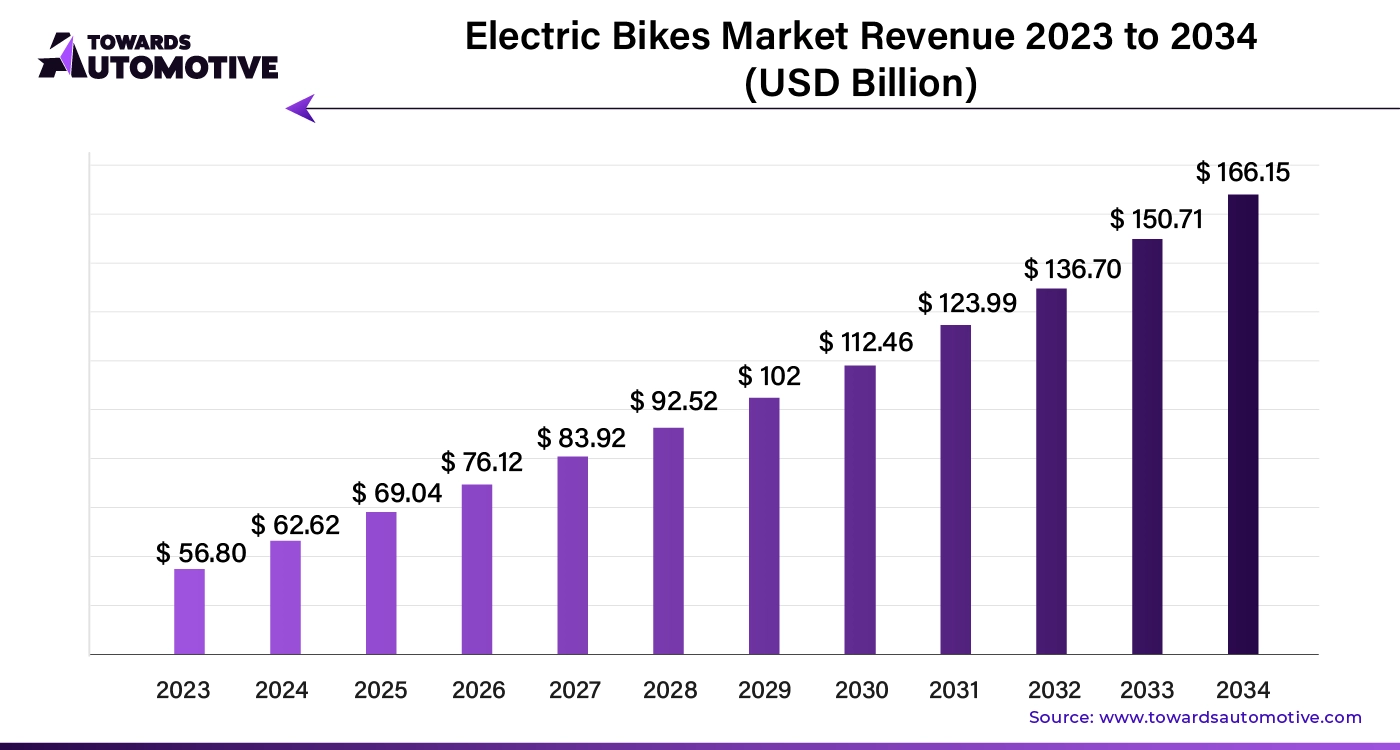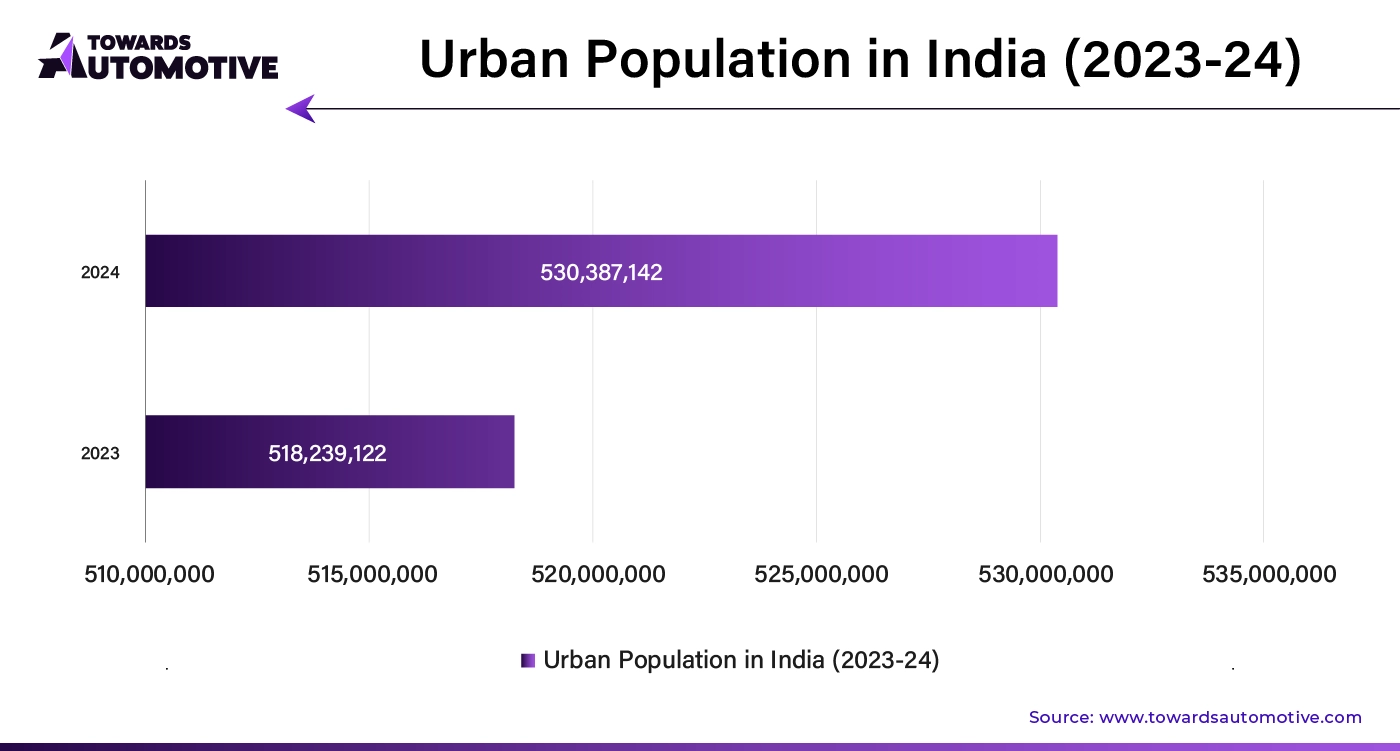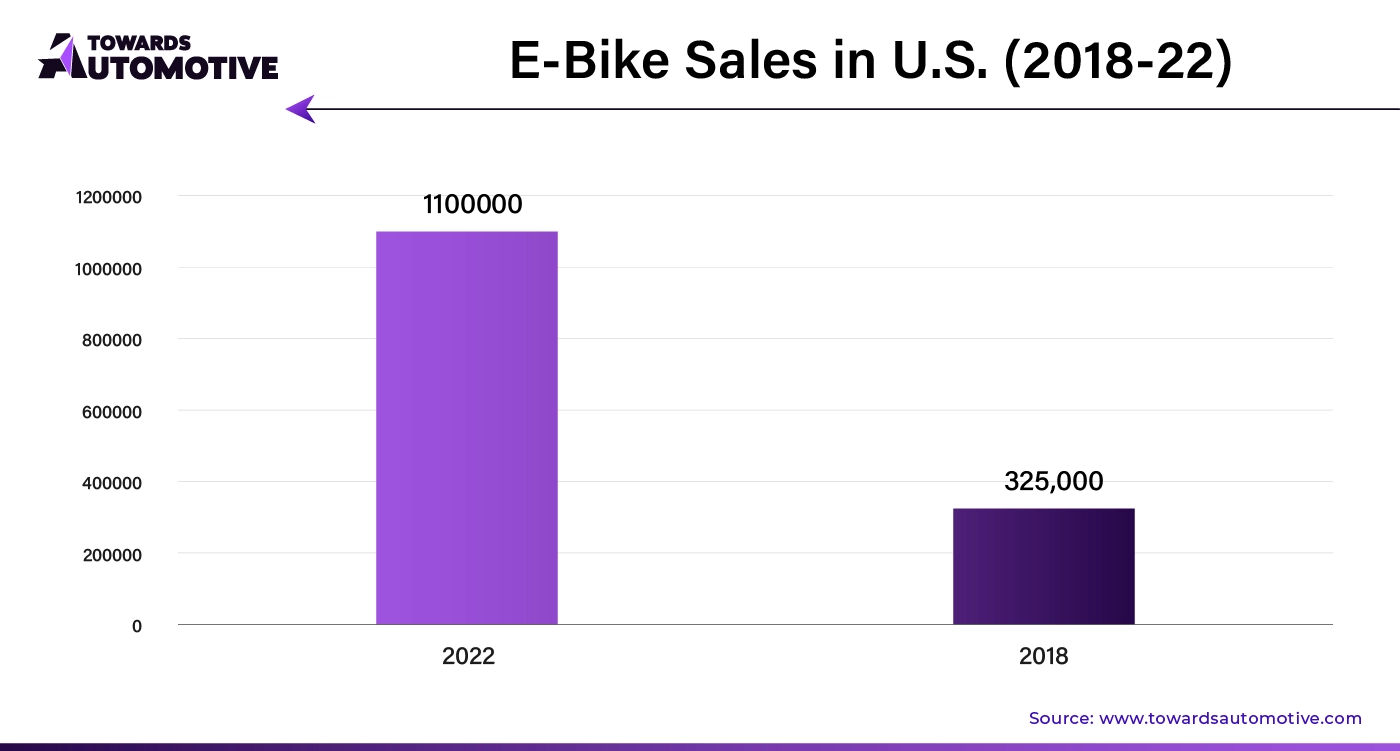April 2025
The global electric bikes market size is calculated at USD 62.62 billion in 2024 and is expected to be worth USD 166.15 billion by 2034, expanding at a CAGR of 10.25% from 2024 to 2034.

Unlock Infinite Advantages: Subscribe to Annual Membership
The electric bikes market is experiencing rapid growth as consumers and cities increasingly seek sustainable and efficient transportation options. Electric bikes, or electric bicycles, combine traditional pedal power with electric motors, offering an eco-friendly alternative to cars and motorcycles for short- and medium-distance travel. The rise in environmental awareness, coupled with government incentives promoting clean transportation, is driving the adoption of electric bikes across urban and rural areas. Additionally, the growing focus on reducing traffic congestion and pollution in cities is making electric bikes a preferred mode of transportation for commuters.
Technological advancements, particularly in battery efficiency and motor performance, have made modern electric bikes more reliable and accessible. Longer battery life, faster charging times, and lightweight designs are attracting a broad spectrum of users, from daily commuters to recreational cyclists. The versatility of electric bikes, with options for urban, mountain, and cargo use, has further expanded their appeal.
Government policies supporting cycling infrastructure, such as dedicated bike lanes and financial incentives for electric bikes purchases, are also boosting market growth. As health-conscious consumers turn to more active modes of transportation, electric bikes provide a convenient solution that blends physical activity with the ease of electric assistance.
With increasing demand for sustainable, affordable, and practical mobility solutions, the electric bikes market is poised for continued expansion. As urbanization rises and cities prioritize green mobility, electric bikes will play a critical role in reshaping transportation for the future.
AI is transforming the electric bikes market by enhancing user experience, improving safety, and optimizing performance. One of the key ways AI is impacting electric bikes is through smart systems that offer personalized riding experiences. AI-powered electric bikes can adjust power output based on rider behavior, terrain, and battery life, providing a smoother, more efficient ride. This adaptability ensures that riders get the most out of their battery range, while also optimizing power usage depending on real-time conditions.
AI also plays a role in predictive maintenance, helping electric bikes owners avoid unexpected breakdowns. Sensors embedded in electric bikes can monitor various components, such as motors and batteries, and use AI algorithms to predict when maintenance is required. This reduces downtime and extends the lifespan of electric bikes by addressing issues before they become critical.
Safety features have also improved thanks to AI. Advanced systems, like collision detection and avoidance, use AI to analyze surroundings and alert riders to potential hazards. AI can also enhance navigation by providing real-time route optimization, helping riders avoid traffic or difficult terrain.
Additionally, AI is facilitating better integration with smartphone apps, allowing riders to track performance, customize ride settings, and monitor battery health. These smart features make electric bikes more appealing to tech-savvy consumers, driving growth in the market. By making electric bikes more efficient, safer, and user-friendly, AI is playing an important role in shaping the electric bikes market in a positive way.
The rise of shared micro-mobility is driving significant growth in the electric bikes market as urban areas increasingly embrace sustainable and convenient transportation solutions. Shared electric bikes services, often integrated into public transportation networks, provide an affordable and eco-friendly alternative for short trips, reducing the need for personal vehicles and alleviating traffic congestion. This shift is especially evident in cities with dense populations, where space for cars is limited, and reducing emissions is a priority.
Operators of shared micro-mobility platforms are rapidly expanding their fleets with electric bikes due to their versatility, ease of use, and lower operational costs compared to other transportation modes. Electric bikes, equipped with electric motors, enable users to travel longer distances with less physical effort, making them ideal for commuters and tourists alike. The convenience of renting an electric bikes for short, on-demand trips contributes to the market’s rapid expansion.
Furthermore, the increasing investment in cycling infrastructure, such as dedicated bike lanes and docking stations, has made shared electric bikes services more accessible and safer for users. Governments and municipalities are also encouraging these services by implementing policies that promote micro-mobility as a sustainable alternative to car travel.
As more cities aim to reduce their carbon footprint and improve urban mobility, the demand for shared electric bikes continues to rise. This growing trend is accelerating the adoption of electric bikes, making them a central player in the shared micro-mobility movement and fueling the overall growth of the electric bikes market.
The electric bikes market faces several restraining factors, including high initial costs due to advanced battery and motor technologies, which make electric bikes more expensive than traditional bicycles. Limited charging infrastructure in some regions also hinders widespread adoption. Additionally, concerns about battery life and durability in harsh weather conditions can deter potential buyers. Finally, regulatory challenges, such as unclear electric bikes classifications and usage restrictions, further slow market growth in certain areas.
The rise of connected electric bikes is creating significant opportunities in the electric bikes market by enhancing the riding experience and attracting a broader range of consumers. Connected electric bikes are equipped with advanced technology, such as GPS tracking, real-time performance monitoring, and smartphone integration, allowing riders to access data and customize their rides. These features provide a personalized and interactive experience, making electric bikes more appealing to tech-savvy users and commuters looking for convenience.
One of the key opportunities connected electric bikes offer is improved security. GPS-enabled electric bikes can be tracked, reducing the risk of theft, a common concern for electric bikes owners. Riders can also monitor their electric bikes remotely, receiving alerts if any unauthorized movement is detected. This added layer of security boosts consumer confidence and encourages more people to invest in electric bikes.
Additionally, connected electric bikes can optimize battery performance by analyzing rider habits and terrain to adjust power output, extending battery life and range. This makes electric bikess more efficient and practical for longer journeys. Manufacturers and fleet operators can also benefit from data collection, allowing for predictive maintenance and performance optimization, reducing downtime and repair costs.
The integration of electric bikes with smartphone apps enables users to plan routes, track fitness goals, and even locate nearby charging stations, further enhancing the riding experience. As connectivity becomes a key feature in electric bikes, it opens up new opportunities for innovation and growth in the electric bikes market, catering to a wider range of consumers and driving market expansion.
The pedelec segment dominated the market. The pedelec (pedal electric cycle) segment is driving the growth of the electric bikes market by offering an ideal balance between traditional cycling and electric assistance. Pedelecs provide electric motor support only when the rider pedals, enhancing the cycling experience without fully replacing the physical effort. This combination attracts a wide range of users, from daily commuters seeking a more energy-efficient way to navigate cities to recreational cyclists who want assistance on longer rides or challenging terrains.
One of the key drivers of the pedelec segment’s growth is its appeal to health-conscious consumers. Pedelecs allow riders to engage in physical activity while offering the flexibility of motor assistance when needed, making cycling more accessible to a broader demographic, including older riders or those with mobility challenges. This versatility has expanded the market beyond traditional cyclists.
In urban areas, pedelecs are becoming a popular solution for commuting, as they offer a faster, more eco-friendly alternative to cars. With increasing congestion and pollution in cities, pedelecs provide a clean, efficient, and affordable mode of transportation. Additionally, government incentives and policies promoting cycling infrastructure, such as dedicated bike lanes and subsidies for electric bikes, are further encouraging pedelec adoption.
As the demand for sustainable, health-oriented, and practical transportation grows, the pedelec segment continues to play a significant role in driving the expansion of the electric bikes market.
The lead-based segment held the largest share of the market. The lead battery segment is driving the growth of the electric bikess market by offering a cost-effective energy solution for electric bicycles. Despite the rising popularity of lithium-ion batteries, lead-acid batteries remain a key choice for many electric bikes manufacturers, especially in emerging markets where affordability is crucial. Their lower production cost compared to lithium-ion batteries makes lead batteries a practical option for budget-conscious consumers and manufacturers looking to offer more accessible electric bikes models.
Lead batteries are also known for their durability and robustness, making them suitable for various weather conditions and long-term usage. Their ability to handle frequent charging cycles without significant degradation is a valuable feature, especially for electric bikes riders in regions with limited access to charging infrastructure. This reliability is appealing to consumers who prioritize long-term performance over cutting-edge technology.
Moreover, the relatively simple recycling process of lead-acid batteries supports the sustainability goals of the electric bikes market. Many countries have established recycling programs, making it easier to manage the environmental impact of lead batteries, which further supports their continued use in the electric bikes industry.
While newer battery technologies are gaining traction, the affordability and durability of lead batteries ensure their role in expanding the electric bikes market, particularly in markets focused on providing affordable and sustainable mobility solutions. These factors collectively drive growth in the lead battery segment, helping to make electric bikes more accessible worldwide.
The battery segment led the electric bikes market. Battery technology advancements are driving the growth of the electric bikes market by significantly improving performance, efficiency, and convenience. Modern electric bikes rely on powerful, lightweight batteries, particularly lithium-ion technology, which offers longer range, faster charging times, and greater energy density compared to traditional lead-acid batteries. These improvements allow electric bikes to travel greater distances on a single charge, making them more practical for commuters and recreational riders alike.
The development of battery technology also enhances the overall user experience. Lightweight batteries reduce the overall weight of electric bikes, improving their maneuverability and ease of use. Fast-charging capabilities further contribute to the convenience of owning an electric bikes, allowing users to quickly recharge and get back on the road. This is particularly appealing in urban areas where time is a crucial factor for commuters.
Additionally, advances in battery management systems (BMS) ensure better energy efficiency and longer battery life by monitoring and optimizing power usage. These systems also enhance safety by preventing overcharging, overheating, or short-circuiting, making electric bikes more reliable and durable over time.
As battery technology continues to evolve, it is expanding the market by making electric bikes more accessible, efficient, and practical for a broader range of users. With these innovations, battery technology is playing a crucial role in driving the growth of the electric bikes market, contributing to its increasing popularity as a sustainable mode of transportation.
Asia Pacific dominated the global electric bikes market. The electric bikes market in Asia Pacific is growing rapidly due to several key factors, including increasing urbanization, environmental concerns, and government initiatives promoting clean transportation. As cities in the region become more densely populated, traffic congestion and pollution have become pressing issues. Electric bikes offer a practical and eco-friendly solution, providing efficient, emission-free transportation for short to medium distances. This has made them increasingly popular among commuters, especially in countries like China and India, where urbanization is at its peak.
Government policies and incentives are also driving the growth of the electric bikes market in Asia Pacific. Several countries have implemented subsidies and tax breaks for electric vehicles, including electric bikes, to reduce their carbon footprint. Investments in cycling infrastructure, such as dedicated bike lanes and charging stations, are making electric bikes more accessible and safer to use.
Technological advancements in battery technology are another key growth driver. Improvements in battery range, charging speed, and durability are making electric bikes more appealing to a wider audience. Additionally, the growing adoption of shared mobility services in urban areas is further expanding the market, with shared electric bikes fleets becoming a common sight in cities across the region.
As the demand for affordable, sustainable transportation solutions rises, the electric bikes market in Asia Pacific is poised for continued growth, with both consumers and governments recognizing their benefits for reducing traffic, pollution, and fuel dependency.

According to the recent data published by Worldometer, the urban population of India was 518,239,122 in 2023 and it reached 530,387,142.
North America is projected to grow with the highest CAGR during the forecast period. The electric bikes market in North America is experiencing robust growth due to several key factors, including increasing environmental awareness, technological advancements, and supportive government policies. As concerns over climate change and urban air pollution intensify, consumers and businesses are seeking sustainable transportation options. Electric bikes offer a practical solution, combining the benefits of cycling with electric assistance to reduce emissions and fuel consumption. This growing environmental consciousness is driving demand for electric bikes as an eco-friendly alternative to traditional vehicles.
Technological innovations in battery performance and electric bikes design are also contributing to market growth. Advances in battery technology, such as longer range, faster charging times, and lighter materials, are enhancing the usability and appeal of electric bikes. These improvements make electric bikes more practical for daily commuting and recreational use, attracting a broader range of consumers.
Government incentives and policies play a crucial role in fostering market growth. In North America, various states and municipalities offer subsidies, tax credits, and rebates for electric bike purchases, making them more affordable for consumers. Investments in cycling infrastructure, including bike lanes and charging stations, further support the adoption of electric bikes by improving safety and convenience for riders.
Additionally, the rise of shared mobility services, including electric bikes rental programs, is expanding market reach and increasing electric bikes visibility. As more people experience the benefits of electric bikes through shared services, demand for personal ownership is also rising. These factors collectively drive the growth of the electric bikes market in North America, positioning it as a key player in the shift toward sustainable transportation.

According to the data published by Office of Energy Efficiency & Renewable Energy, the sales of electric bikes in U.S in 2018 was 325,000 that reached to 1.1 million in 2022.
By Product type
By Battery type
By Technology
By Region
April 2025
April 2025
April 2025
April 2025
We offer automotive expertise for market projections and customizable research, adaptable to diverse strategic approaches.
Contact Us